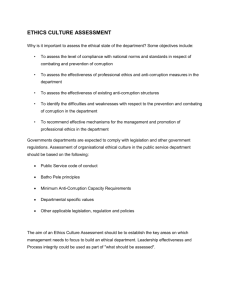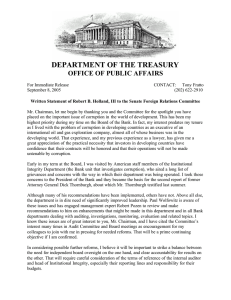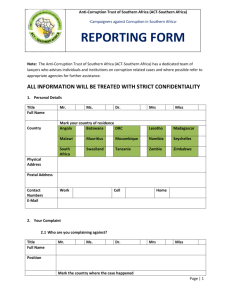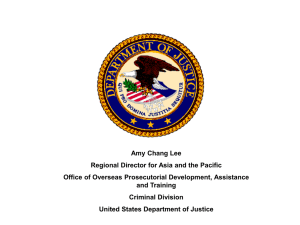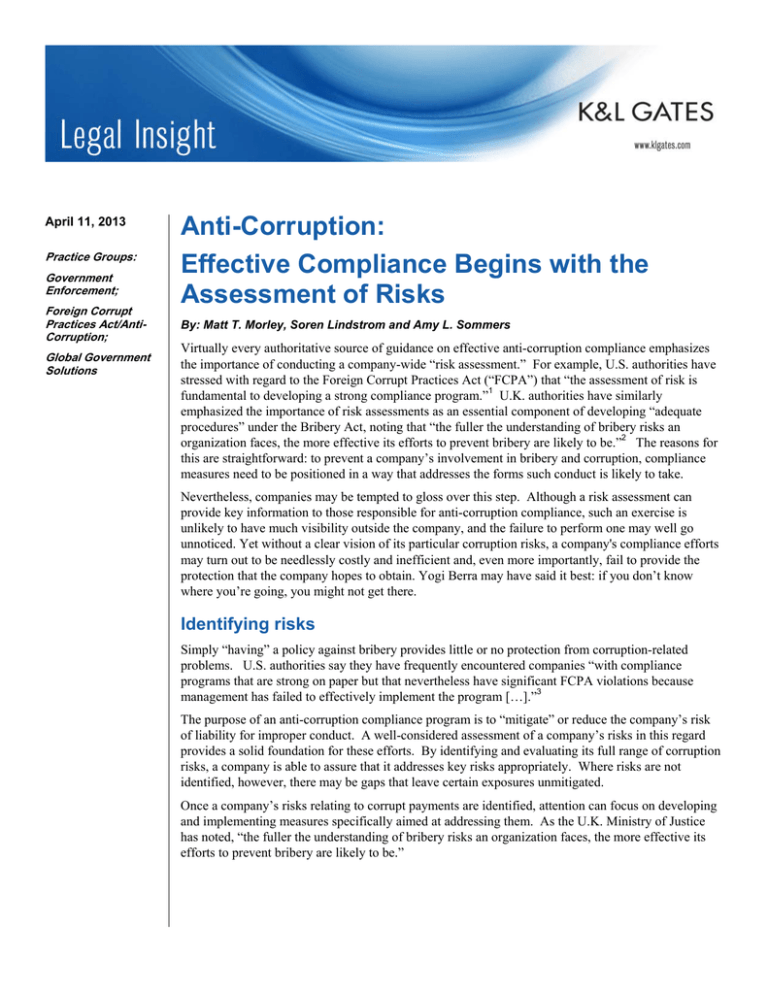
April 11, 2013
Practice Groups:
Government
Enforcement;
Foreign Corrupt
Practices Act/AntiCorruption;
Global Government
Solutions
Anti-Corruption:
Effective Compliance Begins with the
Assessment of Risks
By: Matt T. Morley, Soren Lindstrom and Amy L. Sommers
Virtually every authoritative source of guidance on effective anti-corruption compliance emphasizes
the importance of conducting a company-wide “risk assessment.” For example, U.S. authorities have
stressed with regard to the Foreign Corrupt Practices Act (“FCPA”) that “the assessment of risk is
fundamental to developing a strong compliance program.”1 U.K. authorities have similarly
emphasized the importance of risk assessments as an essential component of developing “adequate
procedures” under the Bribery Act, noting that “the fuller the understanding of bribery risks an
organization faces, the more effective its efforts to prevent bribery are likely to be.”2 The reasons for
this are straightforward: to prevent a company’s involvement in bribery and corruption, compliance
measures need to be positioned in a way that addresses the forms such conduct is likely to take.
Nevertheless, companies may be tempted to gloss over this step. Although a risk assessment can
provide key information to those responsible for anti-corruption compliance, such an exercise is
unlikely to have much visibility outside the company, and the failure to perform one may well go
unnoticed. Yet without a clear vision of its particular corruption risks, a company's compliance efforts
may turn out to be needlessly costly and inefficient and, even more importantly, fail to provide the
protection that the company hopes to obtain. Yogi Berra may have said it best: if you don’t know
where you’re going, you might not get there.
Identifying risks
Simply “having” a policy against bribery provides little or no protection from corruption-related
problems. U.S. authorities say they have frequently encountered companies “with compliance
programs that are strong on paper but that nevertheless have significant FCPA violations because
management has failed to effectively implement the program […].”3
The purpose of an anti-corruption compliance program is to “mitigate” or reduce the company’s risk
of liability for improper conduct. A well-considered assessment of a company’s risks in this regard
provides a solid foundation for these efforts. By identifying and evaluating its full range of corruption
risks, a company is able to assure that it addresses key risks appropriately. Where risks are not
identified, however, there may be gaps that leave certain exposures unmitigated.
Once a company’s risks relating to corrupt payments are identified, attention can focus on developing
and implementing measures specifically aimed at addressing them. As the U.K. Ministry of Justice
has noted, “the fuller the understanding of bribery risks an organization faces, the more effective its
efforts to prevent bribery are likely to be.”
Anti-Corruption: Effective Compliance Begins with an
Assessment of Your Company’s Risks
Prioritizing risks
No company can devote unlimited resources to assuring that it complies with the law – and thus no
compliance program can be perfect. Every company must make choices about where to apply its
compliance efforts. As U.K. authorities have recognized:
No policies or procedures are capable of detecting and preventing all bribery. A risk-based approach
will, however, serve to focus the effort where it is needed and will have most impact.4
By conducting a risk assessment, a company can calibrate its compliance efforts in a sensible manner,
according to the levels of risk identified. These decisions require an understanding of both the
likelihood that an improper payment may be made and what the consequences may be if a payment is
made. By balancing these considerations, companies can allocate their compliance resources in a
sensible and effective way and, through the exercise of examining risks and making such allocations,
be in a better position to explain their actions should questions arise from regulators in the future.
U.S. authorities have also sought to encourage this approach. The DOJ/SEC Resource Guide is
particularly instructive on this point.
One-size-fits-all compliance programs are generally ill-conceived and ineffective because
resources inevitably are spread too thin, with too much focus on low-risk markets and
transactions to the detriment of high-risk areas. Devoting a disproportionate amount of time
policing modest entertainment and gift-giving instead of focusing on large government bids,
questionable payments to third-party consultants, or excessive discounts to resellers and
distributors may indicate that a company’s compliance program is ineffective. A $50 million
contract with a government agency in a high-risk country warrants greater scrutiny than
modest and routine gifts and entertainment.5
Considering sources of corruption risk
Corruption risks vary according to a number of different parameters, and these variations should
inform and refine any risk assessment. The DOJ/SEC Resource Guide notes, in the context of due
diligence, that:
The degree of appropriate due diligence is fact-specific and should vary based on industry,
country, size, and nature of the transaction, and the method and amount of third-party
compensation. Factors to consider, for instance, include risks presented by: the country and
industry sector, the business opportunity, potential business partners, level of involvement
with governments, amount of government regulation and oversight, and exposure to customs
and immigration in conducting business affairs.6
Similarly, U.K. authorities have identified several broad categories of common corruption risks.
Country risk. As suggested by Transparency International’s corruption perception index,7 the
likelihood of a bribe being requested or paid is greater in some jurisdictions than in others.
Sectoral risk. Perhaps because of their relatively high exposure to obstruction by corrupt
governmental authorities, some industries appear to face particularly significant corruption
risks.
Transaction risk. Some types of business transactions, such as obtaining public procurement
projects, seeking necessary product approvals or licenses, and making charitable or political
contributions, may expose a company to relatively greater risks that a corrupt payment will be
2
Anti-Corruption: Effective Compliance Begins with an
Assessment of Your Company’s Risks
requested or made. In addition, certain kinds of projects, such as high value matters, or those
that involve a large number of contractors and intermediaries, may present enhanced
opportunities for corruption, as may projects that include elements not subject to meaningful
market pricing.
Relationship risk. Business relationships involving, for example, third-party intermediaries,
sales agents, distributors or joint venture partners often carry relatively high corruption risks.8
Mapping the company’s risk exposure
Much has been written about the need to identify, analyze and address the company’s specific
corruption risks. This need not be particularly difficult, but it does require methodical consideration
of at least several fundamental questions:
Where might someone have an incentive to make an improper payment to accomplish a
business objective? How likely is this to happen?
Might some company personnel have more of an incentive than others to consider making an
improper payment to achieve their business objectives, whether because of the nature of their
responsibilities or the business environments in which they operate?
If an employee or agent wanted to make an improper payment, what are the various ways they
might seek to accomplish it? What obstacles would they currently face in trying to do that?
How likely is it that they could do so without being detected?
A variety of perspectives on these issues may prove particularly instructive, and a risk assessment may
benefit from the participation by managers at various levels, as well as employees in sales, accounting,
legal and compliance roles. Although every company’s operations are different, many companies are
likely to consider the following issues.
1. Points of contact with government officials. Improper payments to government officials are a
primary focus of anti-corruption law enforcement and any violation of the FCPA will invariably
involve a “government official” in some way. Thus, an important starting place would be to
consider the various points of contact between company personnel (and those acting on behalf of
the company) and government officials. Typically, these points of contact may involve the need to
obtain various governmental approvals, the payment of taxes, or the import or export of various
items. Similar risks may arise in doing business with government-owned or governmentcontrolled entities.
2. Gifts, entertainment, and similar expenditures. Gifts and entertainment expenses are a common
way either to convey an improper payment or to amass a “slush fund” that can be used for off-thebooks payments. An evaluation of these risks would consider, among other things, the types of
gifts and entertainment that are provided and to whom; the amount and frequency of such items;
and whether management approval is required for certain of these expenses. Similar issues may
arise with regard to promotional and marketing expenses, as well as in connection with charitable
contributions or sponsorships by the company.
3. Internal controls. A risk assessment would consider existing accounting controls over the use of
cash and cash equivalents, as well as those in place to assure that assets are used according to
management’s authorization and that transactions are recorded accurately.
4. Retention of agents, consultants and other third-party intermediaries. For many companies, the
single greatest source of corruption risk relates to third parties retained to act on the company’s
3
Anti-Corruption: Effective Compliance Begins with an
Assessment of Your Company’s Risks
behalf, such as agents and other intermediaries. Among the things to be considered here are: what
types of activities do these persons conduct on the company’s behalf? How are they selected?
How are they compensated? Are background checks performed on them? Are appropriate anticorruption provisions included in their retainer agreements?
5. Merger, acquisition and joint venture partners. The actions of these parties are generally not
subject to the company’s control, but can nevertheless create substantial anti-corruption liabilities.
A risk assessment would consider both the nature of the anti-corruption due diligence performed
on these parties and the process for assuring that corruption risks are properly identified and
evaluated.
6. Awareness of company personnel. How aware are company personnel of the company’s anticorruption policies and procedures? What kind of training do they receive? How is that training
and their attendance documented? Are some personnel selected for more intensive training? How
likely are employees to recognize a corruption issue? How likely are they to raise any concerns
they might have in this regard? Does the company have a means for employees to make
anonymous reports if they so choose?
7. Compliance history. Consideration should be given to the company’s previous experiences with
potentially improper payments, offers and requests for payment and any lessons that can be learned
from these events, whether or not any wrongdoing proved to be involved.
Additional steps might be taken where companies face particularly high corruption risks, including
more in-depth inquiries to understand and assess those risks, such as transaction testing of particular
kinds of expenditures or transactions, or particular business locations, involving a review of
supporting documentation and evaluation of compliance with anti-corruption requirements.
Once a company has identified and evaluated its corruption risks, it can proceed to make informed and
considered judgments about which risks to mitigate and how to do so.
A dynamic process: periodic review
While it is essential to undertake a corruption risk assessment when first designing and implementing
an anti-corruption program, the value of such an exercise is not limited to that time period. Indeed,
given the dynamic business and legal environments in which companies operate (including the growth
of a business into new business lines and geographic regions), the nature of the corruption risks they
face is likely to change over time, and periodic risk assessments will enable a company to identify any
new key risks, and to better assure the ongoing effectiveness of its compliance efforts. Both U.S. and
U.K. authorities have said that, in evaluating a company’s anti-corruption compliance efforts, they
will consider the extent to which the programs are regularly reviewed and improved in light of these
factors.
Authors:
Matt T. Morley
Soren Lindstrom
Amy L. Sommers
matt.morley@klgates.com
+1.202.778.9850
soren.lindstrom@klgates.com
+1.214.939.5885
amy.sommers@klgates.com
+86.21.2211.2085
4
Anti-Corruption: Effective Compliance Begins with an
Assessment of Your Company’s Risks
1 A Resource Guide to the Foreign Corrupt Practices Act, published by the Criminal Division of the U.S. Department of
Justice (DOJ) and the Enforcement Division of the U.S. Securities and Exchange Commission (SEC) (2012) (“DOJ/SEC
Resource Guide”) at 58.
2 The Bribery Act 2010 Guidance, issued by the U.K. Ministry of Justice (2011) (“Bribery Act Guidance”) at 25.
3 DOJ/SEC Resource Guide at 57.
4 Bribery Act Guidance at 7.
5 DOJ/SEC Resource Guide at 58.
6 DOJ/SEC Resource Guide at 59.
7 http://www.transparency.org/cpi2012/results
8 Bribery Act Guidance at 26.
Anchorage Austin Beijing Berlin Boston Brisbane Brussels Charleston Charlotte Chicago Dallas Doha Dubai Fort Worth Frankfurt
Harrisburg Hong Kong Houston London Los Angeles Melbourne Miami Milan Moscow Newark New York Orange County Palo Alto Paris
Perth Pittsburgh Portland Raleigh Research Triangle Park San Diego San Francisco São Paulo Seattle Seoul Shanghai Singapore Spokane
Sydney Taipei Tokyo Warsaw Washington, D.C. Wilmington
K&L Gates practices out of 48 fully integrated offices located in the United States, Asia, Australia, Europe, the
Middle East and South America and represents leading global corporations, growth and middle-market companies,
capital markets participants and entrepreneurs in every major industry group as well as public sector entities,
educational institutions, philanthropic organizations and individuals. For more information about K&L Gates or its
locations, practices and registrations, visit www.klgates.com.
This publication is for informational purposes and does not contain or convey legal advice. The information herein should not be used or relied upon in
regard to any particular facts or circumstances without first consulting a lawyer.
©2013 K&L Gates LLP. All Rights Reserved.
5


